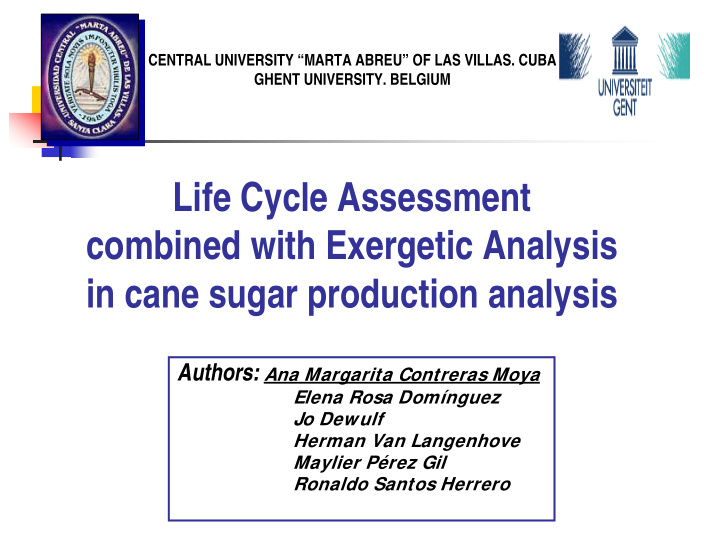



CENTRAL UNIVERSITY “MARTA ABREU” OF LAS VILLAS. CUBA GHENT UNIVERSITY. BELGIUM Life Cycle Assessment combined with Exergetic Analysis in cane sugar production analysis Authors: Ana Margarita Contreras Moya Elena Rosa Domínguez Jo Dewulf Herman Van Langenhove Maylier Pérez Gil Ronaldo Santos Herrero
Content 1. Introduction 2. Methodology to the Life Cycle Assessment (LCA) in the sugar cane industry combined with Exergetic Analysis 3. Application of the methodology 4. Conclusions
1. Introduction Sugar production is a complex system, it includes two stages (agricultural � and industrial) and both generate significant environmental impacts Sugar Industry requires that together with the changes of today � environmental problems will be analyzed Integral utilization of sugar cane by the industrialization of by- products � and the use of waste streams leads to a more sustainable industry It has been widely studied from the techno- economic point of view, but � the environmental contribution has not been assessed scientific and globally. This however is a requirement for the future sustainable society
Sustainability Techno- Economic Environmental Socio- Economic Goals Goals Goals Resource Ecological Human Health Depletion Impact Impact Life Cycle Assessment
Why Life Cycle Assessment combined with Exergetic Analysis (ELCA)? Life Cycle Assessment (LCA) is a tool for the systematic evaluation of environmental aspects of a product or service system through all stages of its life cycle Exergetic Life Cycle Assessment (ELCA) Calculation of Cumulative Exergy Consumption (CExC). It allows to quantify, in terms of exergy, the use of resources during the complete product life cycle
2. Methodology to the LCA in the sugar cane industry combined with Exergetic Analysis LCA Phases (ISO 14040) Goal and Scope Definition Interpretation Inventory Analysis Impact Assessment
START Goal and Scope Definition Life Cycle Inventory New Alternative Exergy Environmental Exergetic Impacts consumption Profile of sugar Analysis Assessment indexes production Interpretation Yes Improvement Introduction? No Final Results Methodology for the Life Cycle Assessment combined with exergetic analysis
Exergetic Life Cycle Assessment (ELCA) � Calculation of Cumulative Exergy Consumption (CExC). (MJ of exergy for the production of a kg of sugar (Szargut et al., 1988; software ‘eXoinvent’, De Meester et al., 2006) ( ) n ∑ = × a ij CE x C X j i = i 1 CE x C --- Cumulative Exergy Consumption of j th product (MJ ex ) j --- Exergy factor of the i th reference flow (MJ ex / reference flow unit) X i a ij --- Cumulative amount of reference flows
3. Application of the methodology System Function and description Scheme of Alternatives ALTERNATIVE I Inputs from Inputs Emissions to air Emissions to water, soil Ecosphere and Sugar and air Technosphere Product: Sugar cane Agricultural Stage Industrial Stage By-product: Molasses Molasses (Avoided product as animal food) (Avoided product as animal food) Agricultural waste Emissions to water Emissions to soil Electricity (National (Avoided product as (Waste water) (Ash and filter network) animal food) cake) ALTERNATIVE II Inputs from Emissions to water, soil Inputs Emissions to air Ecosphere and and air Product: Sugar Sugar Technosphere cane Agricultural Stage Industrial Stage Molasses (Avoided product as Agricultural waste Waste water (as fertilizer) animal food) (Avoided product as Electricity (National animal food) Ash and Filter cake (as fertilizer) network)
ALTERNATIVE III Emissions to water, Emissions to air Inputs from Sugar soil and air Inputs Ecosphere and cane Technosphere Product: Sugar Agricultural Stage Industrial Stage Molasses (Avoided product as animal food) Filter Waste Ash (as fertilizer) Electricity (National network) cake water Sludge (as fertilizer) Agricultural waste Biogas Anaerobic Digestion Waste water (as (Avoided product) (Avoided product fertilizer and fresh as kerosene) water) ALTERNATIVE IV Emissions to Product: Sugar air Emissions to water, Electricity (National Inputs from Inputs Inputs soil and air network) Ecosphere and Sugar Sugar Technosphere cane Agricultural Stage Industrial Stage Distillation Molasses Alcohol and yeast Filter cake + (Avoided product as Waste Waste water gasoline and animal water food, respectively) Ash (as fertilizer) Sludge (as fertilizer) Anaerobic Digestion Biogas Agricultural waste Waste water (as fertilizer (Avoided product (Avoided product) and fresh water) as kerosene)
� Functional Unit : 216 t of sugar � Definition of System boundaries � Allocation � Methodology for the impact assessment � Specifications and limitations
Example: alternative IV
Example of an alternative results Process Network for Alternative IV Daily sugar production Alt IV 6.83E4 Sugar cane Sugar 4.38E4 2.45E4 Use of Electricity Petrol, Biogas Diesel Urea, Combine Irrigating Cogeneration agricultural from sugar low-sulphur, as N harvesting Cuba wastes with bagasse waste 2.41E3 1.54E3 982 1.64E3 - 9.38E3 2.95E4 - 3.42E3 -2.1E3 Electricity Grain maize - 9.7E3 - 2.35E3
Results of Alternatives comparison Impacts evaluation. Total Contribution of each alternative A- I I I A- I V A- I A- I I HUMAN HEALTH ECOSYSTEM QUALI TY RESOURSES Method: Eco-indicator 99 (H)
Results of ELCA Consumption of non-renewable exergy. Alternative I 10.0000 8.0000 6.0000 Exergy (MJ) 4.0000 Agricultural stage 2.0000 Industrial stage Avoided Products 0.0000 -2.0000 -4.0000 -6.0000
Alternatives Comparison Net consumption of non-renewable exergy 6.0000 5.0000 Exergy (MJ) 4.0000 Alternative I Alternative II 3.0000 Alternative III 2.0000 Alternative IV 1.0000 0.0000
4. CONCLUSIONS 1. LCA can be complemented with the ELCA to obtain more solid conclusions on the environmental performance of the cane sugar production process 2. Alternatives comparison shows: advantages in the integration of production processes of sugar, � alcohol from the molasses and biogas from the wastes from both processes that agricultural stage presents the greatest impacts � in the industrial stage: largest impact comes from PM emission � during the co-generation of bagasse non-renewable resources can be saved by the implementation of the � alternatives, especially alternative IV
Life cycle model for the conventional sugar production Fertilizers Land Production resources AGRICULTURAL STAGE Pesticides T Production Emissions Energy Diesel to Air resources Production Sugar cane T Emissions Material HCl to Water resources Production Ca(OH) 2 INDUSTRIAL T Emissions Production STAGE T to Land NaOH Transportation Production Sub-system Sugar By- products DISTRIBUTION AND CONSUMPTION
Recommend
More recommend